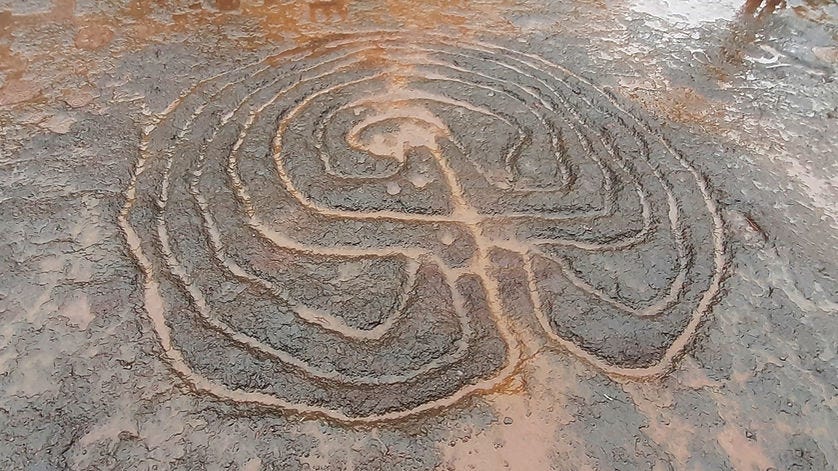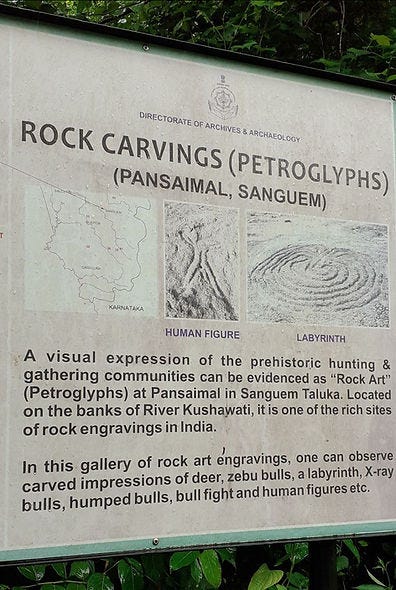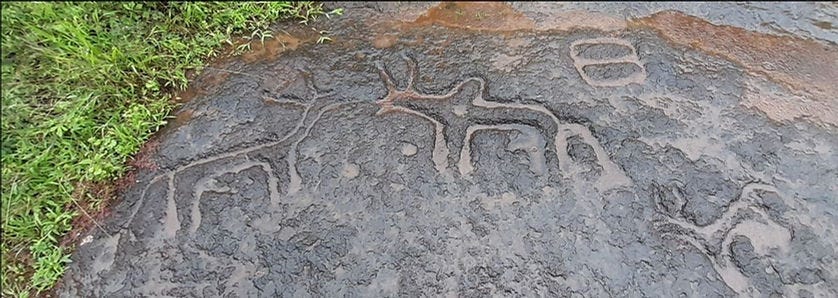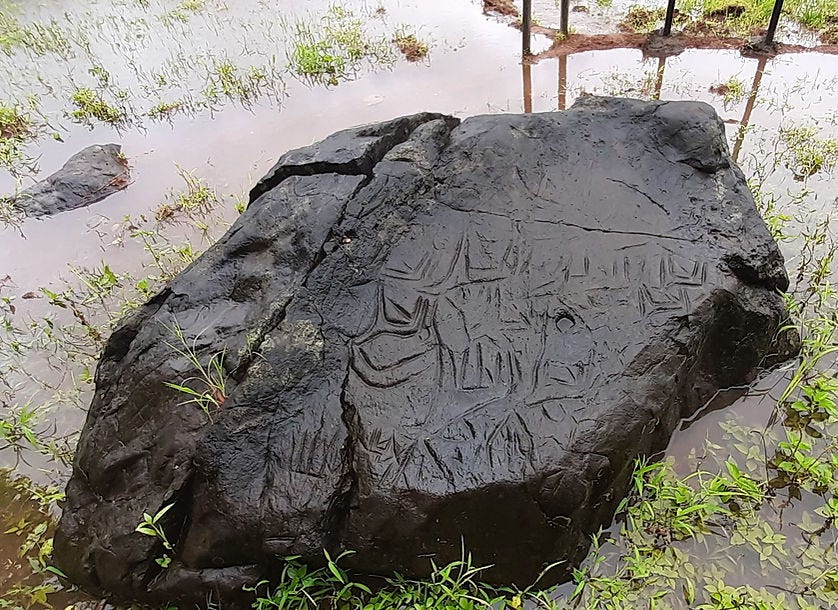Dear Reader,
This edition will focus on the 'echoes of human history', some etched in stone, and other stories that echo across millennia, all offering testimony to the civilizations that were (and are?). So what memories do landscapes hold, what stories do they tell, and how have they helped us piece together what we know of human history?
A decrepit sign off the Tilamol-Rivona road in south Goa, read 'Protected Site - Pansaimal Petroglyphs'. A smaller road wended westwards and ended abruptly at a temple. No further sign to illuminate the journey, no sign of a rock face that might bear petroglyphs, just a cowsherd nearby. We asked for directions, some vague hand gestures followed, and we drove further along a dirt track that led to the river Kushawati. Voila! Another faded sign, and we knew we'd reached our destination.
A one-foot moat forded by a few pieces of not-too-sturdy bamboo brought us to a massive laterite rock dipping towards the rushing, roaring river - another sign hastily explained what the 'gallery of rock art' depicted. We gingerly made our way through the rain, across the slippery rock to find the engravings.
As the rain collected in depressions, we began to see the outlines: a stick-like man, a hump-backed bull, a circular labyrinth, a four-legged horned creature (a goat?). The rock seemed to come alive, as we learned to distinguish the engravings from the rock's natural texture.
Petroglyphs, originating from the Greek words for 'stone' and 'to carve', are images that are cut, carved, incised, or picked into rocks. These are distinguished from rock paintings, also known as petrographs, or pictograms - where natural colours or dyes have been used. Both petroglyphs and petrographs are attributed to prehistoric civilizations, and examples of these can be found on every continent except Antarctica!
Interestingly, most examples of petroglyphs from across the world have been approximately dated back to 10,000-12,000 years, or the Neolithic/New Stone Age, or Upper Paleolithic/Old Stone Age periods, though some date back even further.
The Pansaimal (or Usgalimal, as they are better known, named after the nearby village) petroglyphs approximately date back to 20,000-30,000 years, as per a study by Dr P.P Shirodkar, a former Director of the Goa State Department of Archives and Archaeology - and is among South India's most significant prehistoric sites. Discovered in 1993, they were extensively researched though little of that seems openly available. Yet the state of the site, and the sketchy interpretation signs were a disheartening reminder of just how little we value our (pre)history.
The nearby Kazur/Cajur petroglyphs, I'd heard were more popular. We drove further along that road, followed a sign, and ended up in a patchwork of paddy farms. A gaudy temple and another sign invited us across a mucky landscape, with no path, only the narrow bunds or banks that divided the farms.
Upon reaching, we found one sign that read 'Dudha Fator', the stone of milk, and no further context was provided. The rock itself was a dark slab of basalt (nothing milky about it), busy with ancient scribbles. From where the sign stood, the rock tilted towards us, and it took a while to realise the engravings were upside down. We tried in vain to make sense of the engravings based on the few details provided but saw no axe, nor vulva, just some long-horned animals. Perhaps you'll have better luck deciphering the images below (remember, the figures are upside down)
As we left, I saw a herd of buffaloes with long horns grazing in the fields nearby - they seemed to perfectly connect the threads of the past and the present. A prehistoric, pastoral community tcarved images of their livestock into the rocks nearby, and millennia after, another pastoral community grazes their cattle along the same stretch of river.
So why have I included these petroglyphs as part of an edition titled 'stories etched in stone'? The art on these rock faces themselves, do not depict stories and unlike some rock art, there are no hunting scenes or daily rituals present. Yet to imagine the people who carved these figures - no easy task even today, in the hard laterite rock at Pansaimol, or the granite at Kazur, the tools they must have used, and the reason they left their mark in stone, paints vivid stories about past civilizations. These stories are the purview of archaeology - a study of human past through their material remnants. The rock itself is instrumental in preserving these stories through time, and even if some details have faded, we can piece together an idea of who we were, and where we've come from.
Another reason I've covered petroglyphs is to focus on how many similar prehistoric sites exist in India - ranging from petroglyphs, and pictograms/rock paintings, to dolmens (single-chambered tombs) and other burial sites. Here's a map of some prehistoric sites in India.
Yet I know this is a very incomplete list. Perhaps, you know of a site close to you, or have visited or heard of one? If so, would you like to contribute to this map?
It's easy - here's how you can get started:
- Open the map link below, sign in to your Google account. Under the map title, you will see an EDIT option. Click on it.
- Enter the name of a prehistoric site in the search bar (select from the autocomplete list. If your site isn't on the map yet, you will have to manually drop a pin)
- A box will pop up, click on + Add it to map
- In the same pop-up box, and click edit. You can change the title and add a description (this could be related to your visit or via a link from Wikipedia/elsewhere)
- That's it - you've made your mark!
For the more daring, you can add in your images or videos too - the pop-up box offers you options to change the symbols and colours too. Go on, give it a try?
RELATED POSTS








